Theoretical Investigation of a Coumarin Fluorescent Probe for Distinguishing the Detection of Small-Molecule Biothiols
Abstract
1. Introduction
2. Results and Discussion
3. Theoretical Methods
- The functional and basis set combination CAM-B3LYP/def2-TZVPD was used in structure optimization, corresponding vibrational frequency analysis on the probe, and sensing product conformations with ORCA program 5.1 [30,31,32,33]. Non-imaginary frequency was found in the vibrational analysis on the stable geometric structure, which confirmed the stability of the structure optimization results. The wB2GP-PLYP/def2-TZVPD combination was used in single-point energy to obtain free energy with high precision, according to benchmark research [34]. Similar calculated results were obtained in the gas phase and in several solvents with different polarities, which indicated that this fluorescent probe was insensitive to the solvent effect.
- The electronic structure and fluorescent properties of the probe and its sensing products were obtained through the Multiwfn 3.8(dev) code [35] based on the DFT and TDDFT results through the ORCA program.
- The reorganization energy and Huang–Rhys factors between the S0 and S1 states of the probe and sensing products were obtained through the Dushin program.
- Most of the figures in this work were rendered by means of VMD 1.9.3 software [36].
4. Conclusions
Funding
Institutional Review Board Statement
Informed Consent Statement
Data Availability Statement
Conflicts of Interest
References
- Han, H.; Wang, F.; Chen, J.; Li, X.; Fu, G.; Zhou, J.; Zhou, D.; Wu, W.; Chen, H. Changes in Biothiol Levels Are Closely Associated with Alzheimer’s Disease. J. Alzheimers Dis. 2021, 82, 527–540. [Google Scholar] [PubMed]
- Campodonico, P.R.; Alarcon-Esposito, J.; Olivares, B. Kinetics and Reaction Mechanism of Biothiols Involved in SNAr Reactions: An Experimental Study. Front. Chem. 2022, 10, 142214. [Google Scholar]
- Hu, Y.; Zeng, F. A theranostic prodrug based on FRET for real-time drug release monitoring in response to biothiols. Mater. Sci. Eng. C-Mater. Biol. Appl. 2017, 72, 77–85. [Google Scholar] [PubMed]
- Si, L.; Fu, Q.; Shi, Z.; Zhang, T.; Hou, Q.; Xu, Z.; Ai, S. The fluorescent detection of biothiols and antimicrobial study based on copper(I) iodide coordination polymer. Dye. Pigment. 2023, 215, 2134–2146. [Google Scholar]
- Nagendraraj, T.; Priya, S.V.; Annaraj, J.; Sagadevan, S. Targeted cysteine and glutathione detection in extra/intracellular systems by copper-based fluorescent imaging probes. Coord. Chem. Rev. 2023, 495, 1089–1101. [Google Scholar]
- Ma, C.; Yan, D.; Hou, P.; Liu, X.; Wang, H.; Xia, C.; Li, G.; Chen, S. Bioimaging and Sensing Thiols In Vivo and in Tumor Tissues Based on a Near-Infrared Fluorescent Probe with Large Stokes Shift. Molecules 2023, 28, 5702. [Google Scholar] [PubMed]
- Feng, Q.; Song, Y.; Ma, Y.; Deng, Y.; Xu, P.; Sheng, K.; Zhang, Y.; Li, J.; Wu, S. Molecular engineering of benzenesulfonyl analogs for visual hydrogen polysulfide fluorescent probes based on Nile red skeleton. Spectrochim. Acta Part A-Mol. Biomol. Spectrosc. 2023, 296, 135466. [Google Scholar]
- Sun, Y.; Wang, Y.; Lu, Y.; Kong, X.; Wei, H.; Chen, Q.; Yan, M.; Dong, B. Mitochondria-targeted and FRET-based fluorescent probe for the imaging of endogenous SO2 in living cells. Spectrochim. Acta Part A-Mol. Biomol. Spectrosc. 2022, 265, 110233. [Google Scholar] [CrossRef]
- Bhasin, A.K.K.; Chauhan, P.; Chaudhary, S.; Umar, A.; Baskoutas, S. Highly Sensitive and Selective Sulfite Ion Sensor Based on Biochemically Stable Iodo-Functionalized Coumarin Fluorophores. Chemistryselect 2022, 7, 224361. [Google Scholar] [CrossRef]
- Zhu, Y.; Pan, H.; Song, Y.; Jing, C.; Gan, J.-A.; Zhang, J. Mitochondria-targeted fluorescent probe for rapid detection of thiols and its application in bioimaging. Dye. Pigment. 2021, 191, 3647–3658. [Google Scholar]
- Li, H.; An, Y.; Gao, J.; Yang, M.; Luo, J.; Li, X.; Lv, J.; Li, X.; Yuan, Z.; Ma, H. Recent Advances of Fluorescence Probes for Imaging of Ferroptosis Process. Chemosensors 2022, 10, 233. [Google Scholar] [CrossRef]
- Khan, Z.G.; Patil, M.R.; Nangare, S.N.; Patil, A.G.; Boddu, S.H.S.; Tade, R.S.; Patil, P.O. Surface nanoarchitectured metal-organic frameworks-based sensor for reduced glutathione sensing: A review. J. Nanostruct. Chem. 2022, 12, 1053–1074. [Google Scholar]
- Yang, Q.; Lan, T.; He, W. Recent progress in reaction-based fluorescent probes for active sulfur small molecules. Dye. Pigment. 2021, 186, 3145–3156. [Google Scholar] [CrossRef]
- Su, S.; Chen, Q.; Wang, C.; Jing, J.; Zhang, X. A Sensitive Fluorescent Probe for Homocysteine/Cysteine in Pure Aqueous Media and Mitochondria. Chemistryselect 2021, 6, 8391–8396. [Google Scholar] [CrossRef]
- Raut, J.; Sahoo, P. Detection of Biothiols Using Some Novel Chemosensors: An Overview. Mini Rev. Org. Chem. 2021, 18, 867–884. [Google Scholar] [CrossRef]
- Liu, W.; Chen, J.; Xu, Z. Fluorescent probes for biothiols based on metal complex. Coord. Chem. Rev. 2021, 429, 241756. [Google Scholar]
- Xue, L.; Yu, D.; Sun, J.; Guan, L.; Xie, C.; Wang, L.; Jia, Y.; Tian, J.; Fan, H.; Sun, H. Rapid GSH detection and versatile peptide/protein labelling to track cell penetration using coumarin-based probes. Analyst 2023, 148, 532–538. [Google Scholar] [CrossRef]
- Jiang, H.; Yin, G.; Gan, Y.; Yu, T.; Zhang, Y.; Li, H.; Yin, P. A multisite-binding fluorescent probe for simultaneous monitoring of mitochondrial homocysteine, cysteine and glutathione in live cells and zebrafish. Chin. Chem. Lett. 2022, 33, 1609–1612. [Google Scholar] [CrossRef]
- Hao, Y.; Zhang, Y.; Luo, L.; Zhu, D.; Xu, M.; Zeng, R.; Chen, S. Deep-Red Emissive Fluorescent Probe for Sensitive Detection of Cysteine in Milk and Living Cells. Food Anal. Methods 2022, 15, 2145–2154. [Google Scholar] [CrossRef]
- Zhang, Y.; Xu, C.; Sun, H.; Ren, M.; Kong, F. A Cys-regulated fluorescent probe targeting cancer cells and their application in inflammation detection. J. Photochem. Photobiol. A-Chem. 2023, 444, 7241–7253. [Google Scholar] [CrossRef]
- Wang, Z.; Li, X.; Sun, X.; Zhang, X.; He, C.; Li, Y.; Lu, F.; Lu, X.; Fan, Q. Highly selective imaging of intratumoral hydrogen sulfide by NIR-II emissive fluorescent probes. Sens. Actuators B-Chem. 2023, 384, 6325–6337. [Google Scholar] [CrossRef]
- Chen, X.G.; Mei, Y.; Song, Q.H. A 3-(2′-nitro vinyl)-4-phenylselenyl coumarin as a fluorescent probe for distinguishing detection of Cys/Hcy and GSH. Dye. Pigment. 2022, 203, 11032. [Google Scholar] [CrossRef]
- Kohut, S.V.; Cuevas-Saavedra, R.; Staroverov, V.N. Generalized average local ionization energy and its representations in terms of Dyson and energy orbitals. J. Chem. Phys. 2016, 145, 2568–2574. [Google Scholar] [CrossRef] [PubMed]
- Zamora, P.P.; Bieger, K.; Cuchillo, A.; Tello, A.; Muena, J.P. Theoretical determination of a reaction intermediate: Fukui function analysis, dual reactivity descriptor and activation energy. J. Mol. Struct. 2021, 1227, 129369. [Google Scholar] [CrossRef]
- Sanchez-Marquez, J. New advances in conceptual-DFT: An alternative way to calculate the Fukui function and dual descriptor. J. Mol. Model. 2019, 25, 5214–5226. [Google Scholar] [CrossRef]
- Martinez-Araya, J.I. Why is the dual descriptor a more accurate local reactivity descriptor than Fukui functions? J. Math. Chem. 2015, 53, 451–465. [Google Scholar] [CrossRef]
- Wei, Y.-C.; Hsu, L.-Y. Polaritonic Huang-Rhys Factor: Basic Concepts and Quantifying Light-Matter Interactions in Media. J. Phys. Chem. Lett. 2023, 14, 2395–2401. [Google Scholar] [CrossRef]
- Filipowska, K.; Pawlikowski, M.T.; Andrzejak, M. Optical Spectra of Oligofurans: A Theoretical Approach to the Transition Energies, Reorganization Energies, and the Vibronic Activity. Molecules 2021, 26, 7458. [Google Scholar] [CrossRef]
- Reimers, J.R. A practical method for the use of curvilinear coordinates in calculations of normal-mode-projected displacements and Duschinsky rotation matrices for large molecules. J. Chem. Phys. 2001, 115, 9103–9109. [Google Scholar] [CrossRef]
- Neese, F. Software update: The ORCA program system-Version 5.0. Wiley Interdiscip. Rev.-Comput. Mol. Sci. 2022, 12, 3251–3264. [Google Scholar] [CrossRef]
- Liu, P.; Liu, Y.L.; Huang, H.; Bai, G.; Peng, Y.J. Theoretical investigation on FRET strategy of ratio metric fluorescent probe sensing hydrogen sulfide. Spectrochim. Acta Part A-Mol. Biomol. Spectrosc. 2023, 289, 122223. [Google Scholar] [CrossRef] [PubMed]
- Liu, Y.-L.; Huang, H.; Peng, Y.-J. Fluorescent probe for simultaneous detection of human serum albumin and sulfite: A theoretical analysis. J. Mol. Struct. 2022, 1255, 132441. [Google Scholar] [CrossRef]
- Fu, L.; Huang, H.; Zuo, Z.; Peng, Y. A Single Organic Fluorescent Probe for the Discrimination of Dual Spontaneous ROS in Living Organisms: Theoretical Approach. Molecules 2023, 28, 6983. [Google Scholar] [CrossRef] [PubMed]
- Casanova-Páez, M.; Dardis, M.B.; Goerigk, L. ωB2PLYP and ωB2GPPLYP: The First Two Double-Hybrid Density Functionals with Long-Range Correction Optimized for Excitation Energies. J. Chem. Theory Comput. 2019, 15, 4735–4744. [Google Scholar] [CrossRef]
- Lu, T.; Chen, F. Multiwfn: A multifunctional wavefunction analyzer. J. Comput. Chem. 2012, 33, 580–592. [Google Scholar] [CrossRef]
- Humphrey, W.; Dalke, A.; Schulten, K.K. VMD—Visual molecular dynamics. J. Mol. Graph. 1995, 14, 33–38. [Google Scholar] [CrossRef]
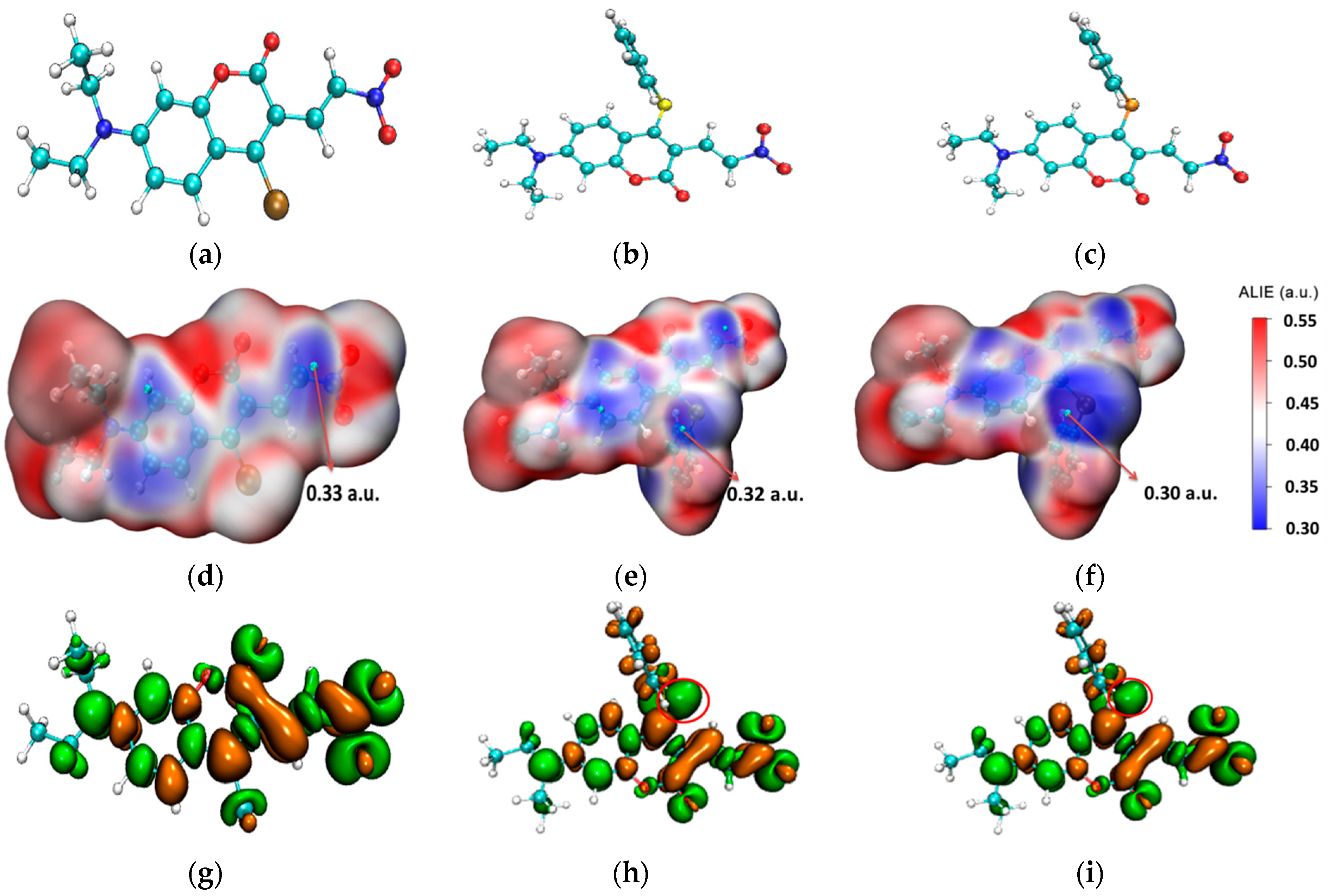
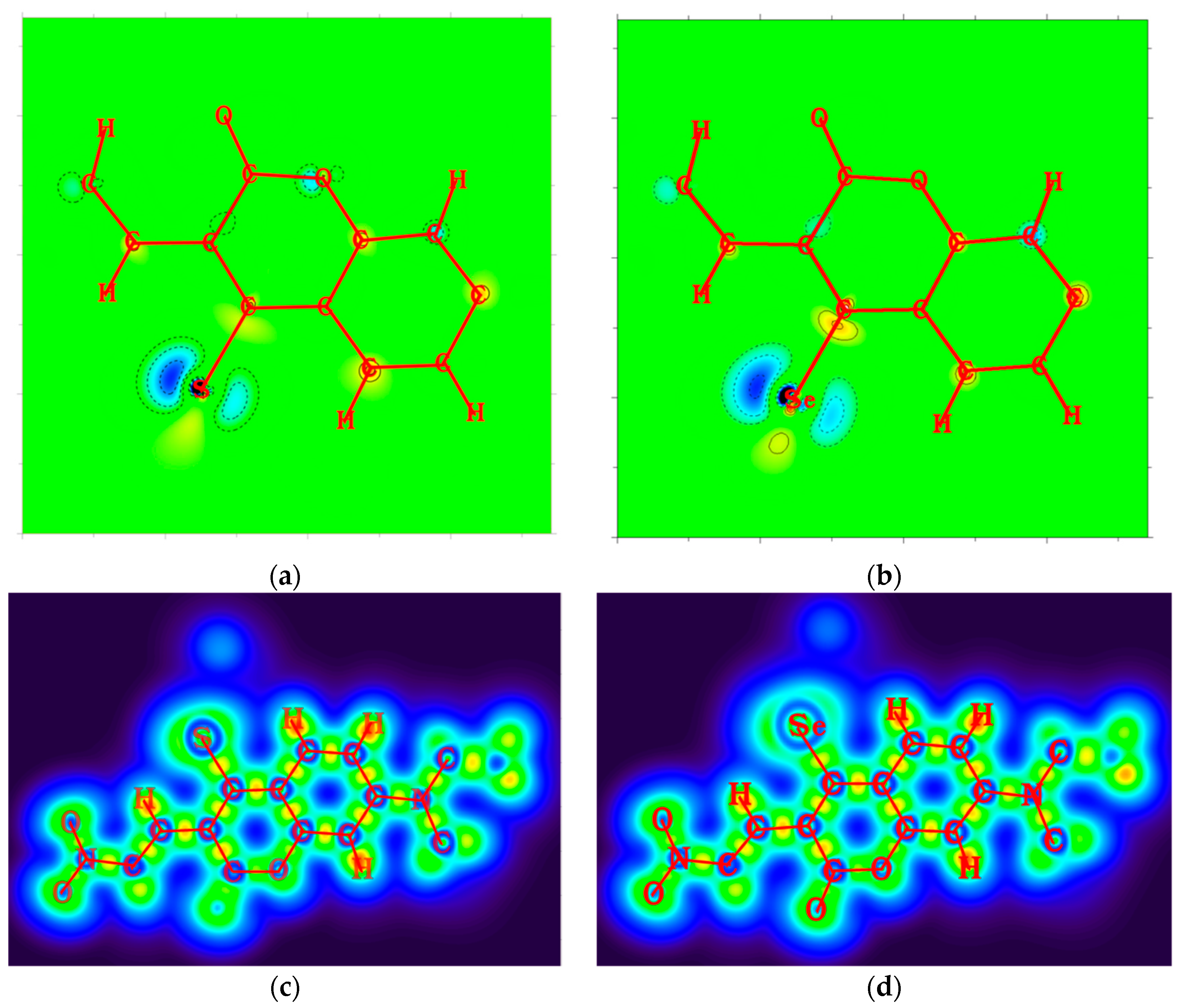
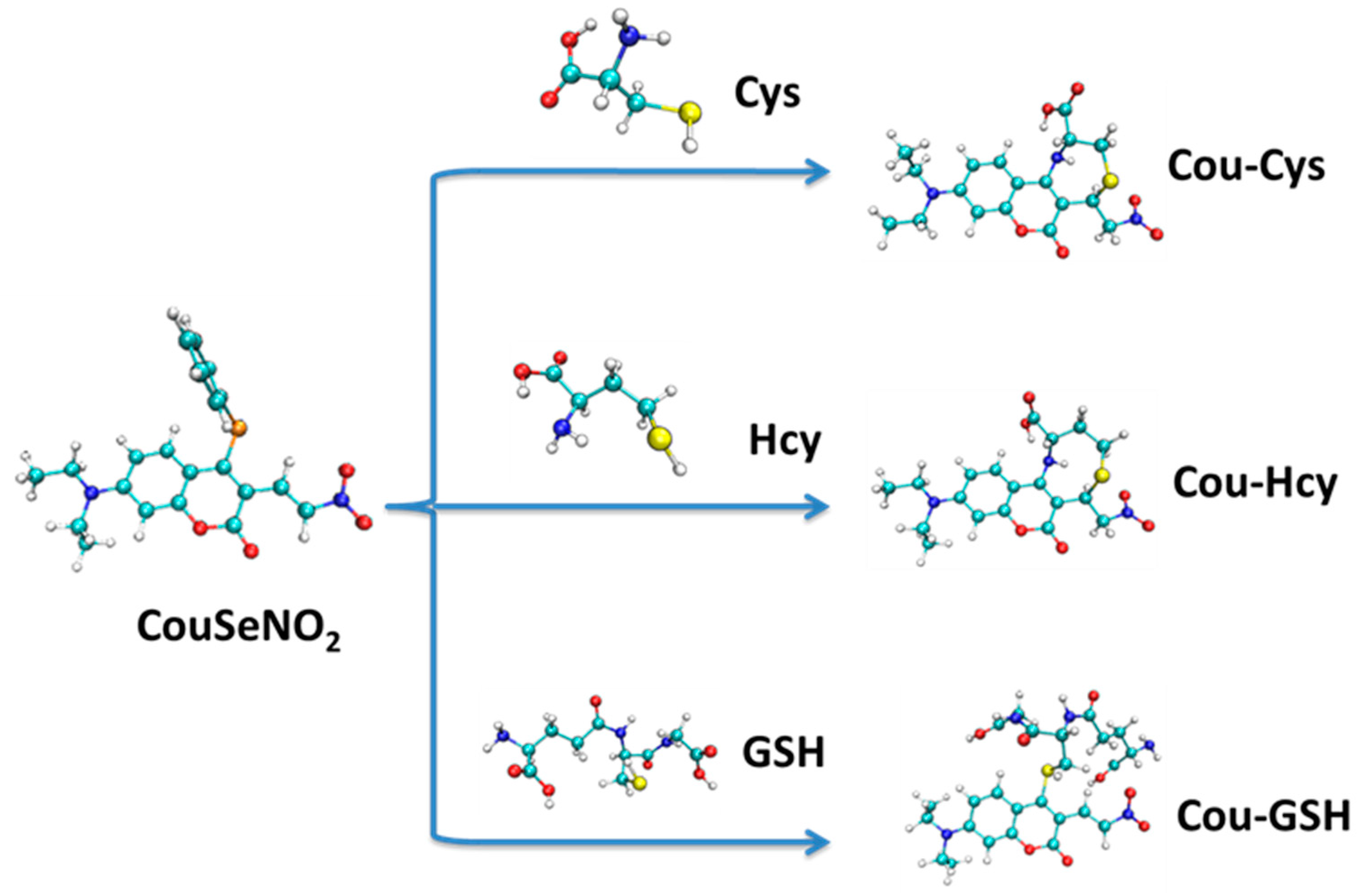

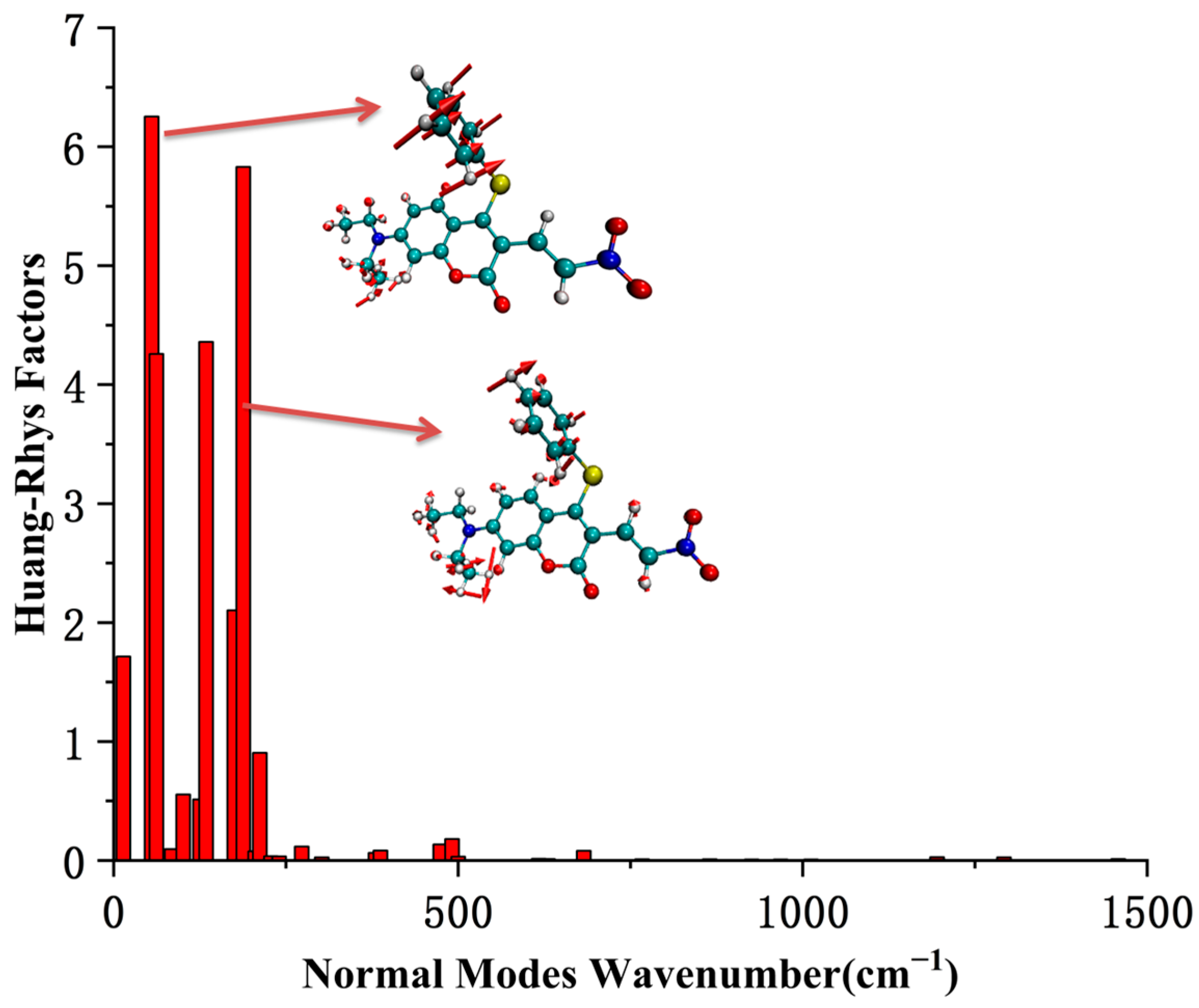
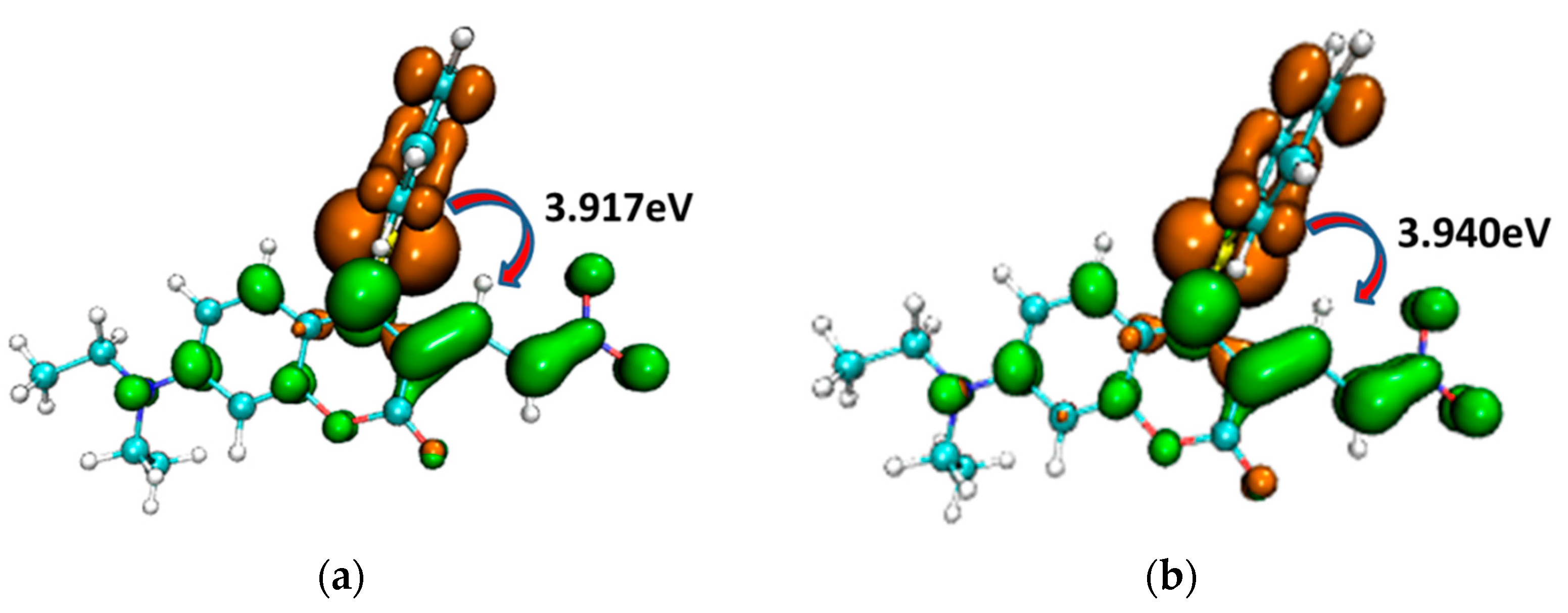

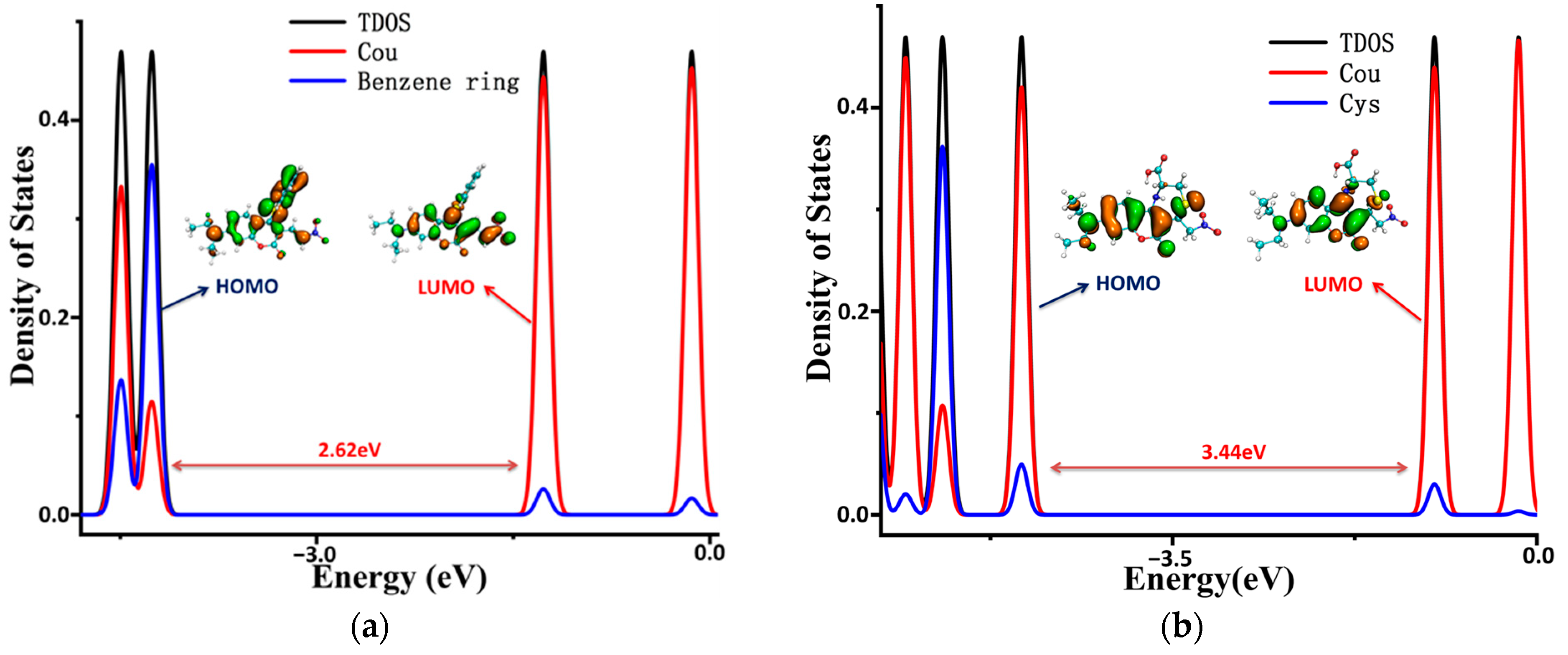
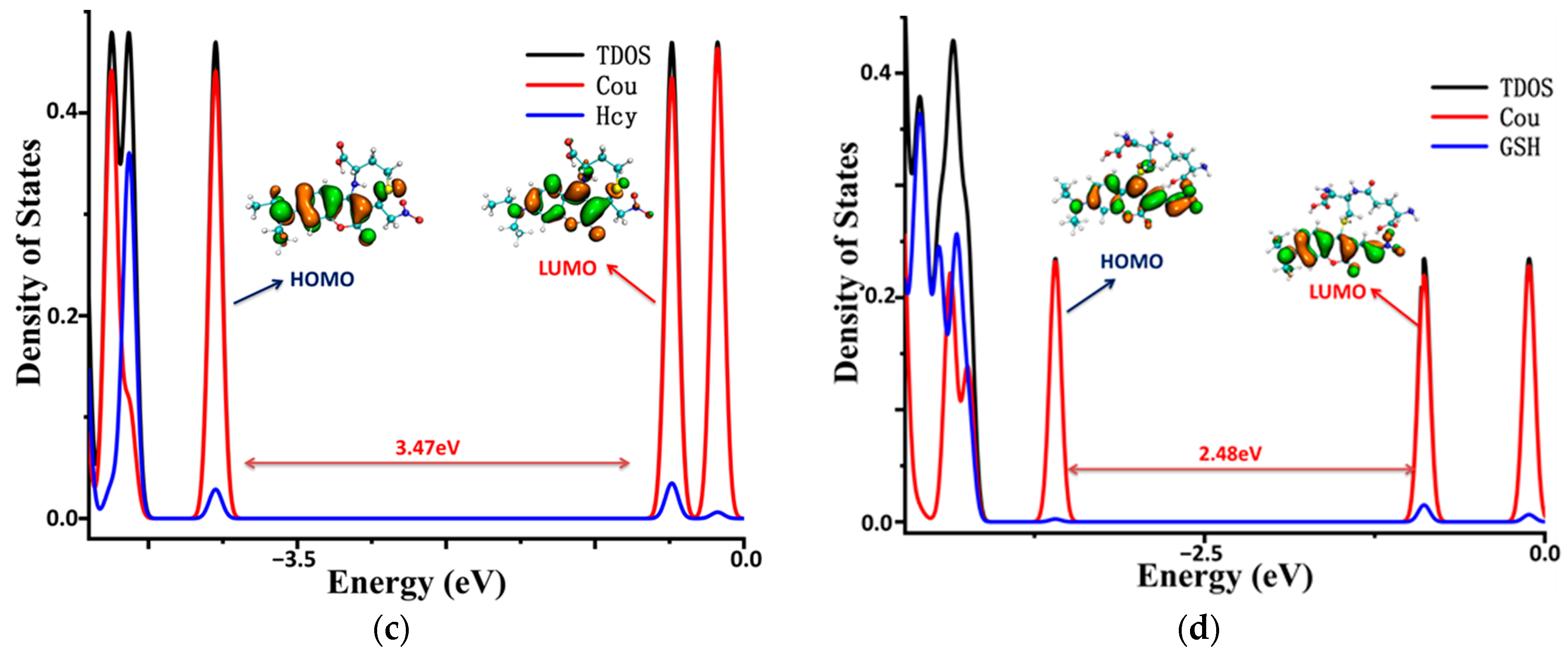
| Probe/Sensing Product | Electronic Transition a | Excitation Energy Theoretical/Experimental (nm) | Oscillator Strength | Composition b | CI c |
|---|---|---|---|---|---|
| CouSeNO2 | S0 → S1 | 473/480 | 0.1063 | H → L | 0.6815 |
| Cou-Cys | S0 → S1 | 360/370 | 0.7921 | H → L | 0.6908 |
| Cou-Hcy | S0 → S1 | 357/365 | 0.8014 | H → L | 0.7014 |
| Cou-GSH | S0 → S1 | 500/515 | 0.7318 | H → L | 0.7219 |
| Probe/Sensing Product | Electronic Transition a | Emission Energy Theoretical/Experimental (nm) | Oscillator Strength | Composition b | CI c |
|---|---|---|---|---|---|
| CouSeNO2 | S1 → S0 | 498/N.A. | 0.0245 | H → L | 0.6726 |
| Cou-Cys | S1 → S0 | 460/465 | 0.7146 | H → L | 0.7017 |
| Cou-Hcy | S1 → S0 | 451/457 | 0.7219 | H → L | 0.7102 |
| Cou-GSH | S1 → S0 | 550/562 | 0.6849 | H → L | 0.7115 |
Disclaimer/Publisher’s Note: The statements, opinions and data contained in all publications are solely those of the individual author(s) and contributor(s) and not of MDPI and/or the editor(s). MDPI and/or the editor(s) disclaim responsibility for any injury to people or property resulting from any ideas, methods, instructions or products referred to in the content. |
© 2024 by the authors. Licensee MDPI, Basel, Switzerland. This article is an open access article distributed under the terms and conditions of the Creative Commons Attribution (CC BY) license (https://creativecommons.org/licenses/by/4.0/).
Share and Cite
Deng, Y.; Huang, H.; Feng, J.; Peng, Y.; Liu, Y. Theoretical Investigation of a Coumarin Fluorescent Probe for Distinguishing the Detection of Small-Molecule Biothiols. Molecules 2024, 29, 554. https://doi.org/10.3390/molecules29030554
Deng Y, Huang H, Feng J, Peng Y, Liu Y. Theoretical Investigation of a Coumarin Fluorescent Probe for Distinguishing the Detection of Small-Molecule Biothiols. Molecules. 2024; 29(3):554. https://doi.org/10.3390/molecules29030554
Chicago/Turabian StyleDeng, Yue, He Huang, Jian Feng, Yongjin Peng, and Yuling Liu. 2024. "Theoretical Investigation of a Coumarin Fluorescent Probe for Distinguishing the Detection of Small-Molecule Biothiols" Molecules 29, no. 3: 554. https://doi.org/10.3390/molecules29030554
APA StyleDeng, Y., Huang, H., Feng, J., Peng, Y., & Liu, Y. (2024). Theoretical Investigation of a Coumarin Fluorescent Probe for Distinguishing the Detection of Small-Molecule Biothiols. Molecules, 29(3), 554. https://doi.org/10.3390/molecules29030554





